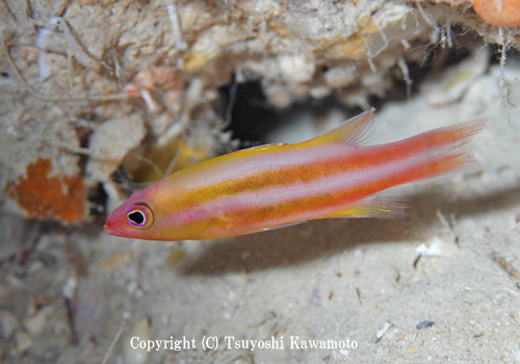Liopropoma tonstrinum is a basslet with equal parts beauty and rarity. Looking superficially similar to L. multilineatum, the former is most often found and captured in Palau, where the few specimens that enter the trade are offered from. According to literature, the range of this species is primarily found along the Central Pacific chain of islands including Palau, Fiji, Caroline and the Marshalls, with a single locality in the Indian Ocean of Christmas Islands. Deep reef exploration, underwater photography as well as captured specimens for the aquarium trade however, has revealed a wider range than we previously thought for this species.

The featured image as well as the image above are two photos of L. tonstrinum photographed in Japan, specificially Kume island and Ogasawara respectively. These are records previously undocumented before in the original description of the species. While Japan lies slightly north-west of Palau and the other Pacific Island chains, the bridge between the two land masses are quite far apart and the appearance of this species in the former may sound like a surprise. Or maybe not.

Recently we’ve received a tip off from Davy Maurice of a single Liopropoma tonstrinum caught off the Philippines sea by Aqua Integrated Marine Products Inc. Like the japanese tonstrinum basslets, this specimen represent a previously undocumented range extension for this species. Looking back at the world map again, we see that Philippines lies south of Japan and West of Palau, possibly bridging the gap between these two chains. Over the years we’ve uncovered many perplexing occurrences and appearances of our favourite fishes in areas we never knew to look for.

We’ve also recently seen L. tonstrinum being captured from the South Pacific, and also filmed in video by Richard Pyle at Moorea, in the French Polynesia. Deep sea exploration has revealed much information and wider range extensions previously known to us, and it makes sense because these fishes are not usually observed by casual diving and collection. The previously cook island endemic Cirrhilabrus claire has been found in the Southern Pacific as well, and the trio of previously known Kwajalein endemics i.e Cirrhilabrus johnsoni, C. rhomboidalis and Paracheilinus bellae have been found in Palau and Yap as well.

Those are just a sample of dozens of range extensions previously undocumented. Now looking back at that Philippines L. tonstrinum, it doesn’t seem like a surprise afterall. Bodianus masudai and Pseudanthias calloura have been caught and photographed respectively in Sulawesi, specifically, the Celebes Sea. The ever popular and illustrious Pseudanthias ventralis is widely documented in Japan, as well as documented from a single Philippines specimen. Centropyge abei, previously a Palau endemic, has been documented in Indonesia as well as a single specimen in Japan.
Take careful notice on the overlapping areas that these deep water fishes are found in. Indonesia, Philippines, Japan and Palau. The underwater range of many of these fishes probably extends well below these massive islands. We as home based aquarists do not venture out in the field much, and such information acquired via the aquarium trade and wildlife photographers gives us an ever so small glimpse into the lives of veteran deepwater specialists such as Rufus Kimura, Brian Greene, Richard Pyle etc.



